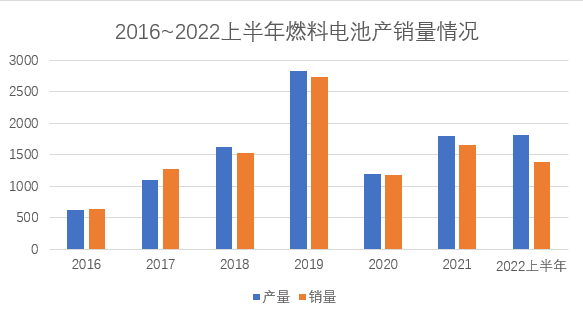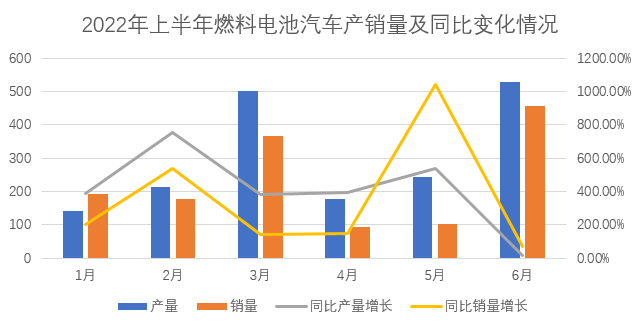

Homepage > Industrial news > In the first half of 2022, fuel cell vehicles grew rapidly, and the development momentum of fuel cell industry was strong.
Hits:2086 Createtime:2022-08-25 09:57:53
The epidemic eased and fuel cell vehicles grew rapidly
China's fuel cell vehicles have been available since 2016, and the annual production and sales volume will reach a peak in 2019. In 2020, affected by the epidemic, the production and sales volume will decline. After the recovery in 2021, the production and sales volume will slowly rise. From January to June this year, the year-on-year growth of fuel cells reached 1.9 times. In the first half of this year alone, the output of fuel cell vehicles exceeded the total output of 2021, and the growth momentum was very rapid. According to the medium and long term plan for the development of hydrogen energy industry (2021-2035), it is estimated that by 2025, the number of fuel cell vehicles in China will reach 50000-100000, and the development of hydrogen energy industry also conforms to the national goal of carbon peak and carbon neutralization, so there will be greater development space for fuel cell vehicles in the future.


Source: data of Ministry of industry and information technology
"Hydrogen" wind slowly, fuel cell stack enterprises take advantage of the development
With the increase of market demand for fuel cell vehicles, fuel cell stacks, as upstream manufacturers, have also achieved great development. According to the data of China hydrogen energy alliance, the annual added market size of fuel cell stacks in China in 2021 is about 620 million yuan. Hydrogen fuel cell stack is mainly composed of catalyst, proton exchange membrane, gas diffusion layer, bipolar plate, seal, end plate, collector plate and other components, and a series of upstream and downstream enterprises including raw materials and equipment manufacturing are gathered. Among them, domestic enterprises represented by Jiping new energy, Zhongke science and technology innovation (production of catalyst), Dongyue future (production of proton exchange membrane) and general hydrogen energy (production of gas diffusion layer) promote the localization of the stack industry in this technology intensive industry dominated by foreign capital.
The fuel cell stack industry still needs to work hard
As commercial vehicles such as buses, buses and logistics vehicles do not have high requirements for the volume of fuel cell stacks and the technical threshold is relatively low, domestic commercial vehicles are the starting point for the development of fuel cell vehicles. Therefore, in terms of the proportion, domestic hydrogen fuel cell vehicles have the characteristics of valuing business and light riding. At present, the volume specific power density of fuel cell engines in China is lower than the advanced level of foreign countries. In the future competition of fuel cell vehicles in the international market, passenger vehicles are a key link. Improving the stability and durability of fuel cell vehicles requires the joint efforts of the fuel cell related industry chains.
Online consultation
>Hotline
400-966-0397




